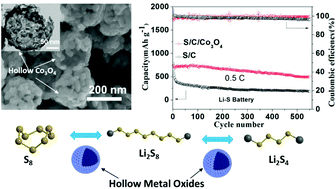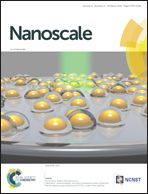Efficient entrapment and catalytic conversion of lithium polysulfides on hollow metal oxide submicro-spheres as lithium–sulfur battery cathodes†
Abstract
Li–S battery technology, with high theoretical capacity and energy density, has drawn much attention in recent years as a possible replacement for current Li-ion battery technologies. A major drawback of Li–S batteries is a severe capacity fading effect which, to a large extent, stems from the dissolution and diffusion of lithium polysulfides (LiPS) that are formed during both charge and discharge cycles. The self-discharge caused by the LiPS migration during the charge process (the so-called “shuttle effect”) often leads to the capacity decay of Li–S batteries. Herein, hollow structured metal oxide (Co3O4, Mn2O3, and NiO) submicro-spheres are prepared by a novel method and employed as efficient LiPS immobilizers. These Li–S batteries, based on the developed metal oxide spheres, possess outstanding rate capability and cycling stability. The best performing S/C/Co3O4 electrode delivers excellent cycling stability with only a 0.066% capacity decay per cycle during 550 cycles. Moreover, its discharge capacity is as high as 428 mA h g−1 at a 3C rate which is far superior to that of bare S/C (115 mA h g−1) at 3C. The fast kinetics of the electrocatalytic conversion of LiPS on the developed Co3O4 electrode and its unique hollow structure are the key factors that lead to its outstanding performance as a Li–S battery cathode material.



 Please wait while we load your content...
Please wait while we load your content...